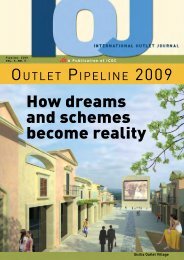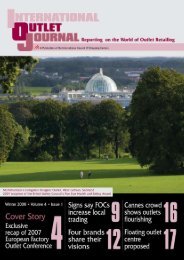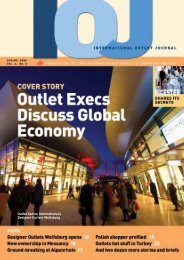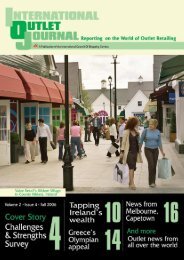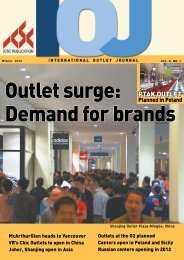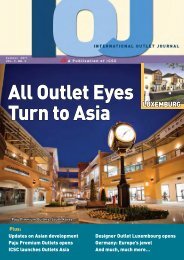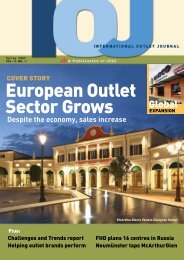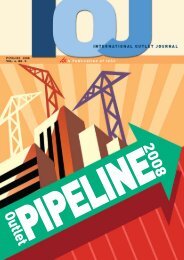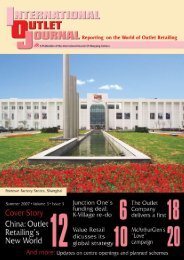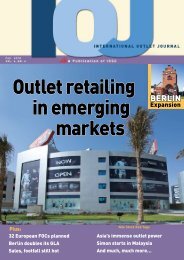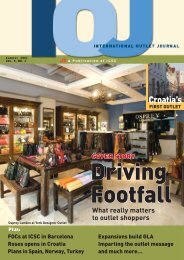For Designer Style, It's All Outlet - Value Retail News
For Designer Style, It's All Outlet - Value Retail News
For Designer Style, It's All Outlet - Value Retail News
You also want an ePaper? Increase the reach of your titles
YUMPU automatically turns print PDFs into web optimized ePapers that Google loves.
SNapShOT ON ChiNa<br />
(continued from page 32)<br />
center in China – Florentia Village – in<br />
June, between Beijing and Tianjin (see page<br />
30). Its second center will be in Shanghai’s<br />
Pudong, close to the future site of Shanghai<br />
Disneyland. There are at least four<br />
more planned Florentia Villages.<br />
n Richly Field, a Hong Kong-listed<br />
development fund, has partnered with<br />
U.S.-based Horizon Group Properties<br />
to develop Globe <strong>Outlet</strong>s across<br />
China. the first of its 10 planned centers<br />
will be in Changsha.<br />
n <strong>Outlet</strong> China Ltd., a joint venture between<br />
state-owned Beijing Capital Group<br />
and Government of Singapore Investment<br />
Corporation, will use the operation<br />
expertise of UK-based Freeport <strong>Retail</strong><br />
and France-based Société de Cooperation<br />
Commerciale et d’Ingenierie pour les<br />
Marques (SCCIM) to develop at least<br />
10 Ballet Towns, planned to be upscale<br />
mixed-use, mid-density new towns anchored<br />
with outlet centers.<br />
n Japan-based Mitsui is showing<br />
interest in further expanding its Chinese<br />
outlet business, in addition to its first<br />
center in Ningbo.<br />
n Private player The <strong>Outlet</strong>! Company,<br />
led by a former executive of Simon<br />
Property Group’s Chelsea platform,<br />
is rapidly acquiring lands with local<br />
partners. In addition to two projects<br />
in Taiwan, The <strong>Outlet</strong>!’s first project<br />
in mainland China most likely will be<br />
in Wuhan, opening in the fall of 2012.<br />
The developer has planned at least five<br />
other outlet projects as well.<br />
n UK-based developer GVA also<br />
recently announced its interest in the<br />
Chinese outlet business.<br />
Increasing partnerships<br />
The operation situation these years has<br />
proved that all types of developers have<br />
unique advantages and shortcomings. To<br />
win this sophisticated market, it is increasingly<br />
difficult to achieve success independently.<br />
Partnerships are often formed in<br />
accordance with the challenges.<br />
State-owned enterprises can usually<br />
leverage their government background<br />
to acquire land and financing from<br />
state-owned banks. However, it takes<br />
time for them to be introduced to international<br />
retailers. In response, they seek<br />
international partners. <strong>For</strong> example,<br />
Bailian partnered with Wharf Holdings<br />
and Walton Brown in its early outlet<br />
operation and <strong>Outlet</strong> China Ltd. is now<br />
34 InternAtIOnAl <strong>Outlet</strong> JOurnAl Fall 2011<br />
the influx of<br />
top brands into<br />
China’s FOCs<br />
bodes well for<br />
the sector.<br />
cooperating with Freeport and SCCIM.<br />
Private companies often come with<br />
abundant equity and strong local relationships.<br />
However, their shortcomings<br />
are leasing and management, so they<br />
usually engage third-party agencies or<br />
directly hire people with retail experience<br />
to address this issue.<br />
<strong>For</strong>eign companies wanting to enter<br />
the Chinese outlet industry frequently<br />
have great relationships with international<br />
retailers. However, they need<br />
time to understand such China-specific<br />
issues as local franchise agreements<br />
and complicated tax codes. Thus, they<br />
seek local partners. <strong>For</strong> instance, RDM<br />
has partnered with Waitex (a Chinese<br />
supply chain and apparel operator), and<br />
Mitsui has partnered with Shanshan (a<br />
Chinese apparel-manufacturer).<br />
Failed and distressed centers<br />
Some outlet centers face multiple challenges<br />
after they open. Some aren’t properly<br />
designed, are difficult to access, have<br />
an unqualified management team, have<br />
the wrong retail channels, or are overwhelmed<br />
by other outlet competitors.<br />
At least two outlet centers were<br />
closed during the past 12 months. They<br />
are Chongqing Windsor <strong>Outlet</strong>s (closed<br />
in July of 2010) and Qingdao Kingcity<br />
<strong>Outlet</strong>s (closed in January of 2011).<br />
Qingdao Kingcity is a textbook example<br />
of a failed Chinese outlet project:<br />
First, being part of a large suburban<br />
mixed-use development, the center<br />
was not initially designed as an outlet<br />
mall. It was designated outlet when the<br />
developer failed to find enough fullprice<br />
anchor tenants.<br />
Second, it is just a few miles from<br />
Kingcity, an enclosed outlet mall that<br />
Shengwen opened a few months later.<br />
During development, neither center was<br />
aware of the other.<br />
Third, the leasing team had a tight<br />
schedule that it couldn’t meet, so the<br />
management team purchased inventory<br />
and opened stores to occupy space.<br />
Fourth, it takes time, typically up to<br />
three years, for an outlet mall in China to<br />
mature and prosper and Kingcity simply<br />
couldn’t sustain for such a long time.<br />
Many more outlet centers in China,<br />
especially those run by inexperienced<br />
local developers or rapidly expanding<br />
commercial real estate developers,<br />
are having the same issues as Qingdao<br />
Kingcity. High vacancy, low sales and<br />
low quality of brands will continue to<br />
trouble these distressed centers. These<br />
congenitally defective outlet malls will<br />
be difficult to turn around.<br />
retailers’ entry into<br />
outlet channels<br />
Chinese outlet developers and owners<br />
have long been struggling with<br />
the retail channels of global brands.<br />
Dealing with distributors makes it<br />
hard to get genuine products and good<br />
discounts for consumers. On the other<br />
side, there is a broader effort by major<br />
international retailers to abandon the<br />
licensing model and increase direct<br />
ownership in China.<br />
Thus, along with new flagship stores<br />
and direct-owned stores rapidly opening<br />
in every major Chinese city, retailers are<br />
seriously assessing the outlet channels<br />
in China. As of January 2011, the ratio<br />
of full-price stores to outlet stores is<br />
about 6:1 for luxury brands in first-tier<br />
Chinese cities (see chart).<br />
Currently, several high-quality outlet<br />
centers in major cities have housed a<br />
number of luxury retailers, a sign that<br />
Chinese outlet centers are being recognized<br />
by world-class tenants.<br />
China’s outlet industry is rapidly<br />
evolving: Chain developers are setting<br />
ambitious plans, often with partnerships<br />
to ensure the quality of the centers. Lowquality<br />
centers quitting the market and<br />
high-quality centers are attracting international<br />
retailers. <strong>All</strong> developers, investors,<br />
retailers and consultants are learning<br />
that careful and detailed due diligence of<br />
outlet retailing is a must before carrying<br />
out any business plans. c<br />
This industry update is a follow-up<br />
of The Rise of Factory <strong>Outlet</strong> Centers<br />
in Mainland China, which appeared<br />
in Vol. 17, No. 2, 2010 of ICSC <strong>Retail</strong><br />
Property Insights and was excerpted<br />
in the Fall 2010 IOJ.





